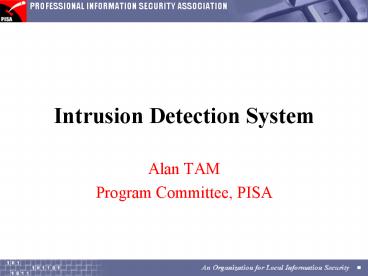Intrusion Detection System - PowerPoint PPT Presentation
1 / 41
Title:
Intrusion Detection System
Description:
Intrusion Detection System Alan TAM Program Committee, PISA Definition and Needs IDS = Intrusion Detection System Not firewall Content inspection Technology Signature ... – PowerPoint PPT presentation
Number of Views:57
Avg rating:3.0/5.0
Title: Intrusion Detection System
1
Intrusion Detection System
- Alan TAM
- Program Committee, PISA
2
Definition and Needs
- IDS Intrusion Detection System
- Not firewall
- Content inspection
3
Technology
- Signature detection
- Anomaly detection
4
General IDS Model
- Sensor
- Analyzer
- Manager
- Administrator
- Operator
5
Basic Classification
- NIDS - Network Based
- e.g. Cisco Secure IDS , Axent Netpowler, Snort,
ISS RealSecure Network Sensor, NAI Cybercop
Monitor - HIDS - Host Based
- e.g. Axent Intruder Alert, ISS RealSecure OS
Sensor, Tripwire
6
Functional Classification
- Packet capturing Pattern matching
- Log parser
- Host firewall
- File integrity checker
- Activity monitor
7
Deployment Tips (1)
- Dual NIC
- No TCP/IP binding
- Network Performance
- Security
- NIC optimization settings
- Promiscuous mode
8
Deployment Tips (2)
- Locations
- DMZ
- In front of firewall
- Behind firewall
- Server segments
- Power user segments
9
Deployment Tips (3)
- Generic OS hardening optimization
- TCP/IP services
- NetBIOS services
- File directory permission
- Useless background process
- Peripherals
10
Deployment Tips (4)
- Miscellaneous
- Automatic mass deployment of HIDS
- Downtime against SLA
- Tuning of false alarms
- Do policy customization (no kidding)
- Monitor log grow-up rate
11
Problem Scenarios (1)
- Signature quality
- False POSITIVES
- False NEGATIVES
- Threshold values
- Duplicates elimination
- Encrypted traffic
- SSL, IPSEC PPTP tunnels, PGP attachment
12
Problem Scenarios (2)
- Switch instead of Hub
- Collision domain
- Port Spanning/Mirroring/Monitoring
- Performance degrade
- High speed network
- Packet drop
- DoS
13
How to choose an IDS (1)
- Attack Signature
- Quality
- Update frequency
- Update mechanism
14
How to choose an IDS (2)
- Scalability
- Traffic handling capacity
- Shutdown mechanism
- Supported platforms (HIDS)
15
How to choose an IDS (3)
- Manageability
- Examining log
- Cross reference
- Archiving
- Centralized console
16
How to choose an IDS (4)
- Hardware platform
- Intel based
- SPARC based
17
Response Actions (1)
- Log
- Header, significant application data
- Raw packet
- Alert
- Console
- SNMP Traps
18
Response Actions (2)
- Termination
- TCP kill
- Kernel drop
- Third-party Integration
- Firewall
- Router
19
Response Actions (3)
- User Script
- Increase log level
- Modem to Pager
- Email to SMS
- Redirect to Honey Pot
20
Previous Battlefield
- IP defragmentation
- TCP stream reassembly
21
Today
- IDS load balancing
- Hardware IDS
- ASIC IDS module in a Chassis
- ASIC Switch appliance
22
Standards
- CVE (Common Vulnerabilities and Exposures)
- IDMEF (Intrusion Detection Message Exchange
Format)
23
CVE (1)
- Standardized name
- Interoperability between tools
- Tool comparison guidelines
- CVE-Compatible
- No. of signatures
24
(No Transcript)
25
CVE (2)
- Version
- As of August 2001 20010507
- Classification
- CVE candidate(CAN-YYYY-XXXX)
- CVE entry(CVE-YYYY-XXXX)
26
Data Sources
- Security Focus - SecurityFocus.com weekly
Newsletters(http//www.securityfocus.com/vdb) - Network Computing and the SANS Institute - weekly
Security Alert Consensus(http//archives.neohapsi
s.com/archives/securityexpress/current/) - ISS - monthly Security Alert Summary(http//xforc
e.iss.net/alerts/summaries.php) - NIPC CyberNotes - biweekly issues(http//www.nipc
.gov/cybernotes.htm)
27
Reference Source
28
Tips for using CVE
- Do not use general terms (e.g. buffer overflow)
to search - Use exact process name (e.g. sendmail)
- Go to the references for Fix
29
IDWG
- Intrusion Detection Working Group
- Aims
- Define data format
- Define exchange procedure
- Outputs
- Requirement document
- Common intrusion language specification
- Framework document
30
IDMEF
- Standard data format (using XML)
- Interoperability
- Typical deployments
- Sensor to Manager
- Database
- Event correlation system
- Centralized console
31
IDMEF Addressed Problems
- Inherently heterogeneous information
- Different sensor types
- Different analyzer capabilities
- Different operation systems
- Different objectives of commercial vendors
32
Message Classes (1)
- IDMEF-Message Class
- Alert Class
- ToolAlert
- CorrelationAlert
- OverflowAlert
- Heartbeat Class
33
Message Classes (2)
- Core Classes
- Analyzer
- Source
- Target
- Classification
- Additional Data
34
Message Classes (3)
- Time Class
- CreatTime
- DetectTime
- AnalyzerTime
35
Message Classes (4)
- Support Class
- Node
- User
- Process
- Service
36
Example
37
Summary
- IDS Classification
- IDS Deployment Considerations
- How to choose an IDS
- Industry standards
38
HKCERT/CC
- Web - http//www.hongkongcert.org
- Telephone - 2788 6060
- Fax - 2190 9760
- Email - mailtoinfosecurity_at_hkpc.org
39
Reference
- http//cve.mitre.org/cve
- http//www.silicondefense.com/idwg/
- http//www.securityfocus.com/
40
Thank You
- For suggestions and corrections, please send
email to - alan.tam_at_pisa.org.hk
- or
- alantam_at_hk.is-one.net
41
Discussion
- SLA - cannot stop service immediately
- Switch to standby system if possible
- Contingency planning
- Trace the source Track its activity































